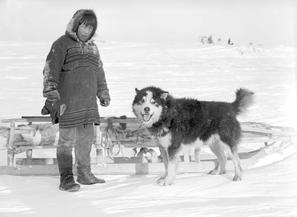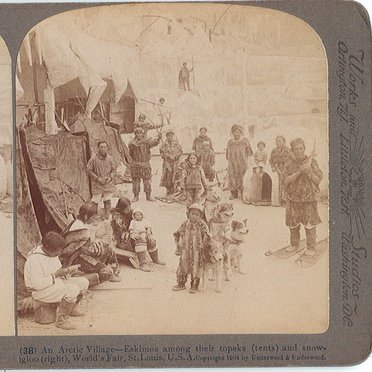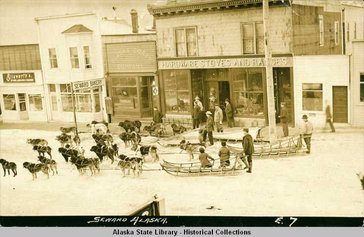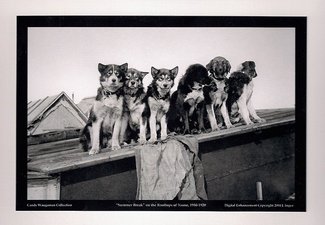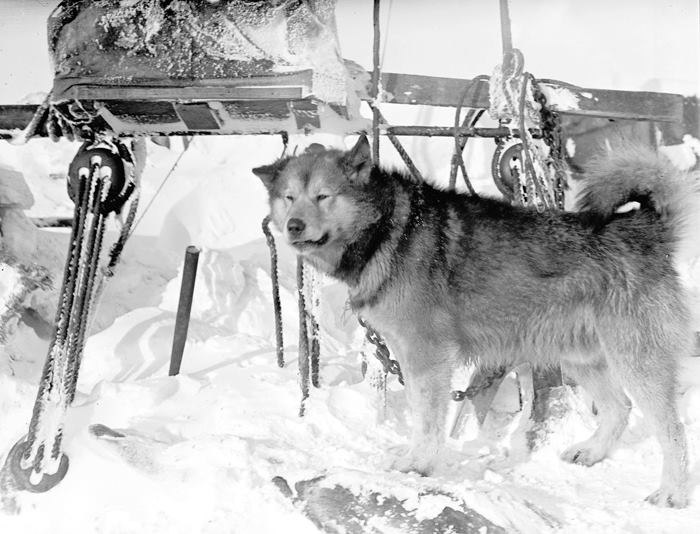About the Alaskan Malamute
'With generations of workers behind him, he makes an exceptionally strong and reliable leader, in that place displaying the cunning, wisdom and trickery that characterizes the breed. No smoother or smarter leader exists. No other can make life so miserable for an inexperienced or cruel musher.' - Jackson B. Corbett Jr. 1908
|
The heavy-freighting dog of the Inuit people who inhabited the shores of the Kotzebue Sound, the Alaskan Malamute excels as an adaptable, intelligent, canine companion. A heavy-boned dog with a bulky muzzle, a broad head, wide-set ears, and a thickly-furred tail carried plume-like over the back, the Malamute is one of the most beautiful dogs on earth and, pound for pound, almost certainly the strongest.
One of the many interesting features of the breed is the natural range in size, color, and markings. The average weight for males is 85 pounds, for females 75 pounds. Many Malamutes, including show dogs, are larger or smaller than average, and bigger is not necessarily better. Most Malamutes are gray with white trim, or black and white, but coats of silver, sable, and red sometimes occur. Patterns of facial markings range from the all-white "open face" to the "full mask" - the combination of a black cap on the head, goggles around the eyes, and a bar down the muzzle. ALL Malamutes have brown eyes. |
The breed is blessed with a sunny disposition. Happiest when treated as an intelligent partner, the Malamute is highly cooperative but never slavish or fawning. The Alaskan Malamute works and lives with you, not for you. Sometimes aggressive toward other dogs, especially those of the same sex, the typical Malamute is outrageously and almost universally friendly to human beings. As the dogs of a peaceful, nomadic people, Malamutes do not guard property and virtually always extend a tail-wagging, face-licking welcome to strangers. These dogs develop deep, complex attachments to their owners, but are not one-person dogs. Adult rescue Malamutes readily bond with their adoptive owners.
The ancestors of today's Malamute were sometimes forced to hunt, forage, and compete for food. Consequently, Malamutes have a predatory streak and, if allowed to run loose in rural areas, will reliably slaughter livestock and wild animals. In urban and suburban areas, a loose Malamute is a menace to cats. Swift, fearless, and powerful, Malamutes have been known to catch songbirds on the wing and, if challenged, to deal harshly with other dogs. Some adult rescue Malamutes get along well with cats and with other dogs, but some must go to homes with no other pets. Furthermore, although the breed boasts a few angels, some Malamutes will raid trash and steal food inside the house. Anyone unprepared to deal firmly and calmly with this wild streak should NOT own an Alaskan Malamute.
|
|
Malamutes can bark, but seldom do. The characteristic vocalization is a long series of woo-woo-woos, but Malamutes also produce yips, growls, rumbles, and an immense variety of wwrrrs and other sounds not readily translated into English. Some Malamutes never howl; others sound a spine-tingling reply to every passing fire engine, ambulance, and police cruiser. The neglected Malamute inappropriately chained in a back yard will loudly and indefatigably protest his situation, but happy Malamutes are exceptionally quiet dogs.
The breed's double coat consists of a short, dense undercoat and an outer coat of coarse guard hair. Malamutes shed profusely about twice a year. Except at those times, they require very little grooming. Some Malamute owners bathe the dog once a year; some, once a month. Some run a brush over the dog now and then; others groom the dog daily. A few Malamutes have long coats that are unacceptable in the show ring - but spectacular elsewhere. "Woollies," as these dogs are called require frequent grooming to prevent mats. Prospective adopters should bear in mind that even a carefully groomed relatively short-coated Malamute that is not actively shedding will nonetheless deposit some fur on carpets and in automobiles. This is NOT the breed for the fastidiously house-proud or car-proud. |
Purebred, neutered Malamutes are eligible for American Kennel Club Indefinite Listing Privilege registration; a rescue Malamute with an ILP number may be entered in Obedience, Agility, or Rally at AKC trials. As a competitive trial dog, the Alaskan Malamute is more legendary for crowd-pleasing antics than for good scores. Each year, however, Malamutes earn American Kennel Club Obedience, Agility, Rally, and Tracking titles, and the breed is tremendous fun to work with, if not always a joy to show in the ring. In contrast, the Malamute is easy to train as a well-mannered pet.
The prospective adopter who has never before owned any dog should consider a sedate older Malamute instead of a spunky young dog, as should anyone without the physical strength to handle a vigorous youngster. Fortunately, the Alaskan Malamute has a life-span of about 12 to 14 years. Thus a 5-year old Malamute has, on the average, more years ahead of him than does a five-day-old Irish Wolfhound.
The prospective adopter who has never before owned any dog should consider a sedate older Malamute instead of a spunky young dog, as should anyone without the physical strength to handle a vigorous youngster. Fortunately, the Alaskan Malamute has a life-span of about 12 to 14 years. Thus a 5-year old Malamute has, on the average, more years ahead of him than does a five-day-old Irish Wolfhound.
